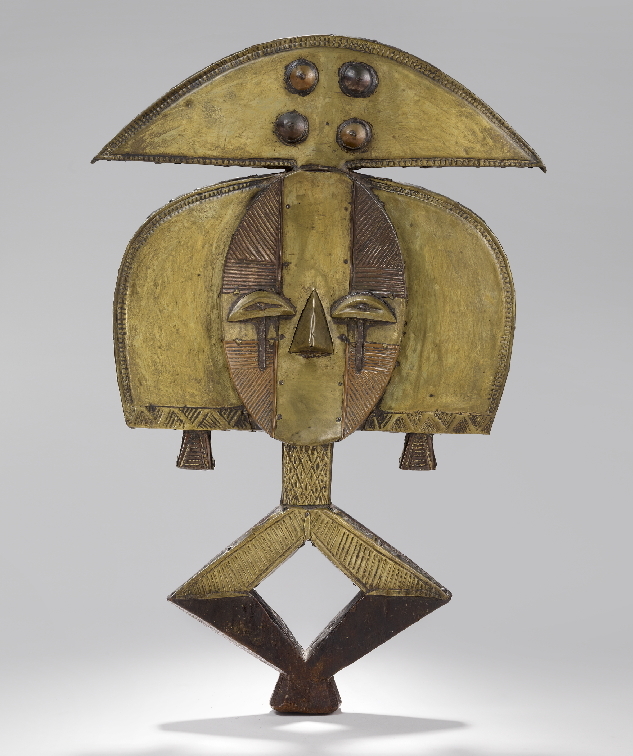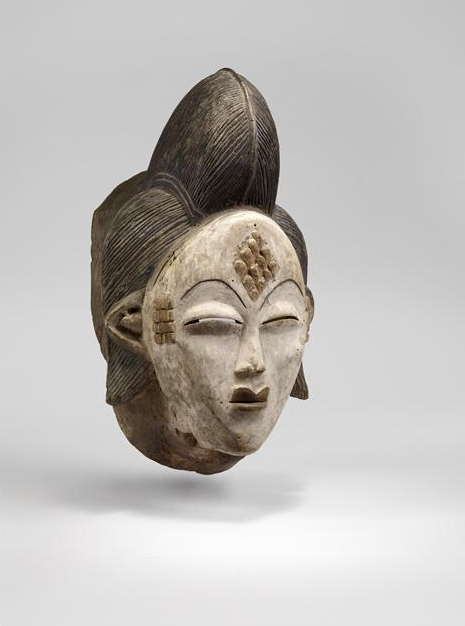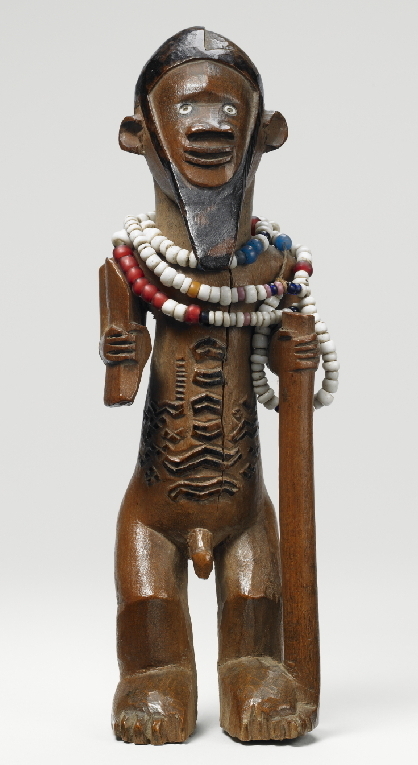Art exhibits spirit of central Africa
‘Congo River ? Art of Central Africa’ to feature 71 African sculptures
By Korea HeraldPublished : Oct. 22, 2013 - 19:27

Not many people know that the tight-lipped curvaceous lady in Picasso’s “Les Demoiselles d‘Avignon,” multi-faced but primitive and dynamic women of Braque, or the long-faced expressionless ladies of Modigliani were inspired by artifacts from far away central Africa.
Perceived as exotic when European colonialists brought back statues from Congo, the full lips with rounded waists ― symbols of fertility, longevity and good fortune ― as well as stern facial expressions captivated the 19th and 20th century artists in many ways.
Koreans will be able to feel the raw and energetic, while at the same time slightly reserved, world of Congolese art at the National Museum of Korea’s “Congo River ― Art of Central Africa” exhibition that opened on Tuesday at the Special Exhibition Gallery and runs through Jan. 19.
A total of 71 statues and items on loan from Musee de quai Branly, which boasts a vast collection of central African art, are on display. The exhibit is composed of three sections: “masks generally shaped like hearts,” “statues of ancestors (which often contain bones and relics),” and “representation of women.”
“It hasn’t been long since the vision of African art became a major place of sculptures. I believe some of the best sculptures in the world are from Africa. And no one, of course in Asia, was aware of that,” said Stephane Martin, director of Musee de quai Branly, on Monday at the press briefing for the exhibition.
Perceived as exotic when European colonialists brought back statues from Congo, the full lips with rounded waists ― symbols of fertility, longevity and good fortune ― as well as stern facial expressions captivated the 19th and 20th century artists in many ways.
Koreans will be able to feel the raw and energetic, while at the same time slightly reserved, world of Congolese art at the National Museum of Korea’s “Congo River ― Art of Central Africa” exhibition that opened on Tuesday at the Special Exhibition Gallery and runs through Jan. 19.
A total of 71 statues and items on loan from Musee de quai Branly, which boasts a vast collection of central African art, are on display. The exhibit is composed of three sections: “masks generally shaped like hearts,” “statues of ancestors (which often contain bones and relics),” and “representation of women.”
“It hasn’t been long since the vision of African art became a major place of sculptures. I believe some of the best sculptures in the world are from Africa. And no one, of course in Asia, was aware of that,” said Stephane Martin, director of Musee de quai Branly, on Monday at the press briefing for the exhibition.

Heart-shaped masks
Masks in the shape of a heart were quite popular among the Bantu people, which has 15 sub-tribes in the central Congo area, along the 4,700-kilometer Congo River, the second longest river in Africa following the Nile. The Bantu believed that the shape would keep away bad fortune and bring health and prosperity.
The mask shaped like an antelope, which also resembles a heart, represents the spirit of the forest.
“Men were hunters and whenever an epidemic broke out they created the mask and held an exorcism to warn disease off,” said Yang Seong-hyeok, curator and researcher of the state-run museum.
The facial expressions of a double-sided mask aren’t too distinctive since the mask is usually plastered with white mud, which represents ghosts of the deceased.
“The Bantu believed that this would bring the ancestors to guard them from any danger,” Yang explained, adding that they do not have mouths to symbolize “keeping the confidentiality of the community.”
Masks in the shape of a heart were quite popular among the Bantu people, which has 15 sub-tribes in the central Congo area, along the 4,700-kilometer Congo River, the second longest river in Africa following the Nile. The Bantu believed that the shape would keep away bad fortune and bring health and prosperity.
The mask shaped like an antelope, which also resembles a heart, represents the spirit of the forest.
“Men were hunters and whenever an epidemic broke out they created the mask and held an exorcism to warn disease off,” said Yang Seong-hyeok, curator and researcher of the state-run museum.
The facial expressions of a double-sided mask aren’t too distinctive since the mask is usually plastered with white mud, which represents ghosts of the deceased.
“The Bantu believed that this would bring the ancestors to guard them from any danger,” Yang explained, adding that they do not have mouths to symbolize “keeping the confidentiality of the community.”

Statues of ancestors
Like Koreans, Africans revered their ancestors and believed that the spirit of the deceased could do them harm or good. Many times, they would create a small sculpture on top of urns or a skull to commemorate their beloved and respected ones. In the Bembe culture, a Bantu-speaking tribe, the social status of the deceased was reflected in the statue: those holding swords were warriors, while those with bottles were shamans and those with long rods were administrators.
Several exhibited sculptures from the Mbede tribe depict ancestors. One has shells and buttons, which means that the person was engaged in trade, a wealthy person in the community. Bones and relics were often wrapped in a clean cloth and tucked into the cavity of the statue, then plastered with white mud, which became Nkisi nkondi, a tool for shamanic rituals.
Like Koreans, Africans revered their ancestors and believed that the spirit of the deceased could do them harm or good. Many times, they would create a small sculpture on top of urns or a skull to commemorate their beloved and respected ones. In the Bembe culture, a Bantu-speaking tribe, the social status of the deceased was reflected in the statue: those holding swords were warriors, while those with bottles were shamans and those with long rods were administrators.
Several exhibited sculptures from the Mbede tribe depict ancestors. One has shells and buttons, which means that the person was engaged in trade, a wealthy person in the community. Bones and relics were often wrapped in a clean cloth and tucked into the cavity of the statue, then plastered with white mud, which became Nkisi nkondi, a tool for shamanic rituals.

Representation of women
In the culture of the Savannah, women play important roles as rulers, priestesses, honored mothers and powerful ancestors. The high status of women among the Bantu-speaking people is also shown in the matrilineal descent system, or the tracing of families through the women.
The most notable statue is perhaps the female figure by the Lubas. The woman has the perfect oval facial structure, almond eyes, face tattoo of nine diamonds, perfectly arched eyebrows, plump lips and narrow a nose with rather pale skin.
“This was the standard of beauty back then. The interested thing is that it resembles Kabuki actors’ makeup of Japan. Therefore, in the 19th century and early 20th century, when the central African art was first introduced to Europe, people thought Africans were heavily influenced by the Japanese. But that’s nonsense. It was pure coincidence, but worth noting,” Yang said.
One other item to look at is the stool with a female figure.
Women were regarded sacred as they give birth to the next generation and nurture them. Therefore a stool where a woman is seen to support the seat bodes good fortune and good connection with Mother Earth and security.
Most of the exhibited items are from the 19th and 20th centuries, as wood is prone to decay and damage.
“But we can still feel the pure beauty of Africa,” said Kim Young-na, director of the national museum.
By Bae Ji-sook (baejisook@heraldcorp.com)
In the culture of the Savannah, women play important roles as rulers, priestesses, honored mothers and powerful ancestors. The high status of women among the Bantu-speaking people is also shown in the matrilineal descent system, or the tracing of families through the women.
The most notable statue is perhaps the female figure by the Lubas. The woman has the perfect oval facial structure, almond eyes, face tattoo of nine diamonds, perfectly arched eyebrows, plump lips and narrow a nose with rather pale skin.
“This was the standard of beauty back then. The interested thing is that it resembles Kabuki actors’ makeup of Japan. Therefore, in the 19th century and early 20th century, when the central African art was first introduced to Europe, people thought Africans were heavily influenced by the Japanese. But that’s nonsense. It was pure coincidence, but worth noting,” Yang said.
One other item to look at is the stool with a female figure.
Women were regarded sacred as they give birth to the next generation and nurture them. Therefore a stool where a woman is seen to support the seat bodes good fortune and good connection with Mother Earth and security.
Most of the exhibited items are from the 19th and 20th centuries, as wood is prone to decay and damage.
“But we can still feel the pure beauty of Africa,” said Kim Young-na, director of the national museum.
By Bae Ji-sook (baejisook@heraldcorp.com)
-
Articles by Korea Herald



![[Exclusive] Korean military set to ban iPhones over 'security' concerns](http://res.heraldm.com/phpwas/restmb_idxmake.php?idx=644&simg=/content/image/2024/04/23/20240423050599_0.jpg&u=20240423183955)

![[Graphic News] 77% of young Koreans still financially dependent](http://res.heraldm.com/phpwas/restmb_idxmake.php?idx=644&simg=/content/image/2024/04/22/20240422050762_0.gif&u=)



![[Pressure points] Leggings in public: Fashion statement or social faux pas?](http://res.heraldm.com/phpwas/restmb_idxmake.php?idx=644&simg=/content/image/2024/04/23/20240423050669_0.jpg&u=)










